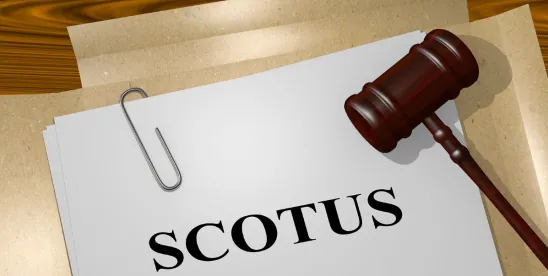The Supreme Court has issued its last three decisions of the 2023 term, and its summer recess has begun.
However, while the Justices and Court personnel might be at apparent rest, the future effect of today’s decisions will be significant, both immediately and for years to come.
The Court led the day, as expected, with the long-awaited decision in Trump v. United States. Given the broad scope of the remand of the case and the Court’s 6–3 conservative/liberal split, most of the headlines likely will suggest that Trump has prevailed, especially because of conservative Justices that he himself had appointed. Indeed, though most of his arguments have been rejected by the Chief Justice and those who concurred with him, the former president has gained the thing he likely most wanted: delay. There is no way conceivable, at least to this writer, that this case can be resolved before the upcoming presidential election. Whatever the ultimate resolution of the matter might be, that alone will raise a host of new questions, especially if the former president is reelected. But those are matters more immediately for the political arena, and this blog is about the law and the effects upon which the decision might have longer-term implications. So, let’s look at what the Court says the law is.
The Trump case is about the separation of powers. Given the nature of presidential power, the Court holds that a former president is entitled “to absolute immunity from criminal prosecution for actions within his conclusive and preclusive constitutional authority. And he is entitled to at least presumptive immunity from prosecution for all his official acts. [But, t]here is no immunity for unofficial acts.” Thus, there is “at least a presumptive immunity from criminal prosecution for a President’s acts within the outer perimeter of his official responsibility. Such an immunity is required to safeguard the independence and effective functioning of the Executive, and to enable the President to carry out his constitutional duties without undue caution. At a minimum, the President must be immune from prosecution for an official act unless the Government can show that applying a criminal prohibition to that act would pose no ‘dangers of intrusion on the authority and functions of the Executive Branch.’” “As for a President’s unofficial acts, there is no immunity,” and prosecution, therefore, is not barred.
All of this begs the question of how a court is to determine into which of the three categories of immunity, or the lack of it, a given act of a president fits. “The first step in deciding whether a former President is entitled to immunity from a particular prosecution is to distinguish his official from unofficial actions. In this case, no court thus far has drawn that distinction, in general or with respect to the conduct alleged in particular.” The role of the Court is for final review, not initial review, but the Court can offer guidance here. “When the President acts pursuant to ‘constitutional and statutory authority,’ he takes official action to perform the functions of his office. Determining whether an action is covered by immunity thus begins with assessing the President’s authority to take that action. But the breadth of the President’s ‘discretionary responsibilities’ under the Constitution and laws of the United States frequently makes it ‘difficult to determine which of [his] innumerable “functions” encompassed a particular action.’”
Immunity necessarily extends to the “outer perimeter” of the president’s official responsibilities, covering actions so long as they are “not manifestly or palpably beyond [his] authority.” But, in dividing between official and unofficial conduct, courts may not inquire into the president’s motive, which would be so “highly intrusive” and “risk exposing even the most obvious instances of official conduct.”
Looking to specifics, the Court considered types of conduct alleged in the Special Counsel’s indictment, “such as those involving Trump’s discussions with the Acting Attorney General—are readily categorized in light of the nature of the President’s official relationship to the office held by that individual. Other allegations—such as those involving Trump’s interactions with the Vice President, state officials, and certain private parties, and his comments to the general public—present more difficult questions.” Rather than answering the question with respect to that type of activity, the Court has remanded the case for lower court analysis in the first instance. The Court rejected the broad scope of immunity that the former president argued and concluded by stating that “[t]he President enjoys no immunity for his unofficial acts, and not everything the President does is official. The President is not above the law. But under our system of separated powers, the President may not be prosecuted for exercising his core constitutional powers, and he is entitled to at least presumptive immunity from prosecution for his official acts. That immunity applies equally to all occupants of the Oval Office.” These are majestic words, but words in this case that are of greater long-term consequence for the nation than immediate effect on an uncertain political environment that will be resolved by the people who come to vote, and not the Court.
Another 6–3 opinion, this one authored by Justice Barrett with concurrences from the other five jurisprudential conservatives, is that resolving the case of Corner Post, Inc. v. Board of Governors of the Federal Reserve System. While the Trump case might have a profound long- and short-term impact on the United States as a whole, the Corner Post case, especially in view of the Court’s reversal of Chevron last week, is going to have a significant effect with regard to challenges to government regulatory actions. In short, added to the list of cases that includes West Virginia v. EPA and Loper Bright Enterprises v. Raimondo, the Court in Corner Post continues to weaken the power of administrative agencies.
Corner Post is a merchant that accepts debit cards for payment. In 2021, it joined a suit brought against the Federal Reserve Board under the Administrative Procedure Act (APA), claiming that a particular regulation improperly allows higher interchange fees than the governing statute permits. The U.S. District Court for the District of North Dakota dismissed the suit as time-barred under 28 U. S. C. §2401(a), the default six-year statute of limitations applicable to suits against the United States or its agencies, and the U.S. Court of Appeals for the Eighth Circuit affirmed.
The Supreme Court reversed, holding that an APA claim does not accrue for purposes of 28 U.S.C. §2401(a)’s six-year statute of limitations until the plaintiff is injured by final agency action. In so doing, the Court rejects the Board’s view that an APA claim “accrues” under §2401(a) when agency action is “final” from the standpoint of promulgation, even before a plaintiff suffers an injury. Instead, the Court holds that “[a] right of action ‘accrues’ when the plaintiff has a “complete and present cause of action,” which is when she has the right to “file suit and obtain relief.” “Because an APA plaintiff may not file suit and obtain relief until she suffers an injury from final agency action, the statute of limitations does not begin to run until she is injured. In sum, as Justice Barrett states, “We must decide when a claim brought under the Administrative Procedure Act ‘accrues’ for purposes of this provision. The answer is straightforward. A claim accrues when the plaintiff has the right to assert it in court—and in the case of the APA, that is when the plaintiff is injured by final agency action.”
This is the right answer if for no other reason than that the Supreme Court says so. However, the dissenters in the case have a point in asserting that the APA’s statute of limitations has been extended potentially for indeterminable, lengthy periods. This is a very consequential decision that not only weakens agency autonomy but also strengthens the ability of plaintiffs to challenge agency action that might not have adverse consequences long after it is administratively final.
While some might argue that the Court has taken a weak swing in not finally determining certain issues in the Trump case, others will argue that the Court has acted tepidly in Moody v. Netchoice. Justice Kagan wrote the operative opinion of the Court, in which she was joined by the Chief Justice and Justices Sotomayor, Kavanaugh, and Barrett, but there is a panoply of concurrences. The case itself is, for the obvious reason that it involves the media, highly publicized. The Court dealt with the issue of whether two state laws, Florida’s and Texas’s, regulating social media platforms and other websites facially violate the First Amendment. These laws restrict the ability of social media platforms to control whether and how third-party posts are presented to other users. “As such, they limit the platforms’ capacity to engage in content moderation—to filter, prioritize, and label the varied messages, videos, and other content their users wish to post.” They also “require a platform to provide an individualized explanation to a user if it removes or alters her posts.”
NetChoice, an internet trade association, challenged both laws on their face—as a whole rather than as to any particular applications. The Court noted that the cases came to it at an early stage, on review of preliminary injunctions. The Eleventh Circuit upheld the challenged Florida injunction against the platforms, finding that the Florida law was not likely to survive First Amendment review. On the opposite tack, the Fifth Circuit reversed a similar injunction, reasoning that the Texas law does not regulate any speech and so does not implicate the First Amendment. Without deciding the ultimate question, the Supreme Court vacated both decisions, without reference to the First Amendment merits, because neither Court of Appeals properly considered the facial nature of NetChoice’s challenge. “The courts mainly addressed what the parties had focused on. And the parties mainly argued these cases as if the laws applied only to the curated feeds offered by the largest and most paradigmatic social-media platforms—as if, say, each case presented an as-applied challenge brought by Facebook protesting its loss of control over the content of its News Feed. But argument in [the Supreme] Court revealed that the laws might apply to, and differently affect, other kinds of websites and apps. In a facial challenge, that could well matter. . . .” Thus, the Court noted that the issue in a case such as this one “is whether a law’s unconstitutional applications are substantial compared to its constitutional ones. To make that judgment, a court must determine a law’s full set of applications, evaluate which are constitutional and which are not, and compare the one to the other. Neither court performed that necessary inquiry.” It took 31 pages of timeless prose to vacate the judgments of the two Circuits and remand the case for further proceedings.
This has been a most eventful year at the Court and the summer that almost is upon us is a good time to reflect on it. Dear readers, please enjoy it.




 />i
/>i

